Imagine sailing the frigid North Sea, your wooden vessel creaking against the swells when suddenly, the water around you begins to churn. Not from wind or current, but from something moving beneath the surface. The sea darkens as an entity vast beyond comprehension rises from the depths—its arms, thick as ship masts, breaking the water's plane one by one. This is no ordinary beast, but the Kraken—the colossus that haunted Norse sailors' nightmares and now bridges the tenuous space between folklore and scientific reality.
"The fact that an animal this size remained unfilmed for so long and undiscovered by science is both surprising and exciting. It just emphasizes how much we have yet to learn about our oceans." - Dr. Clyde Roper, Smithsonian zoologist
For centuries, the Kraken represented our most primal nautical fear—not merely of drowning, but of being claimed by the deep through the agency of something alive and deliberate. Yet what’s most fascinating about this legend is its remarkable journey from superstition to scientific discovery, a rare case where mariners' tales contained kernels of truth that would eventually rewrite marine biology textbooks.
THE LEGEND: ORIGINS IN NORSE WATERS
The word "kraken" derives from the Old Norse "krake," meaning an unhealthy animal or something twisted. The earliest written accounts appear in the Norse sagas, though the oral tradition undoubtedly extends deeper into antiquity.
The 13th-century Örvar-Odds saga describes a creature called the "hafgufa" (sea mist), so enormous that sailors mistook it for an island and anchored upon its back—only to perish when the beast submerged. This motif of the deceptive island-beast appears across maritime cultures, suggesting either cultural transmission or independent observations of something genuinely enormous disturbing the sea surface.
By the 18th century, the Kraken had entered scientific literature through Bishop Erik Pontoppidan's Natural History of Norway (1752), where he described it as "incontestably the largest sea monster in the world" with a back "one and a half miles in circumference." Pontoppidan noted that fishermen reported excellent catches when working near the Kraken, as its presence drove fish to the surface—a detail later vindicated by our understanding of deep-sea ecology.
Most significantly, Pontoppidan recorded the creature's physical appearance: not as a serpent or turtle-like being, but as something with numerous arms or appendages "as thick as a ship's mast." Here we see the first scientific description aligning with what we now recognize as a giant cephalopod.
THE CONVERGENCE: WHEN MYTH ENCOUNTERED SCIENCE
The scientific community long dismissed Kraken accounts as sailors' superstitions—until the evidence literally washed ashore. In 1853, a strange, decomposing mass approximately 55 feet long stranded on a Danish beach. Naturalist Japetus Steenstrup examined preserved parts of this "sea monk" and identified it as tissue from a giant squid, a creature science had yet to formally recognize.
The turning point came in November 1861, when the French warship Alecton encountered a giant squid floating near Tenerife. The crew attempted to capture it but managed only to secure a portion of the tail. Lieutenant Frédéric Bouyer's official report described a creature with eight arms, brick-red coloration, and eyes the size of dinner plates. For the first time, a military officer with scientific training had documented an encounter with what could only be the Kraken's biological counterpart.
Then in 1873, Canadian fishermen near Newfoundland struck the jackpot of cryptozoology. A giant squid attacked their boat, and they managed to hack off one of its tentacles. This 19-foot appendage, preserved in formaldehyde, finally provided irrefutable physical evidence. In a remarkable coincidence, Reverend Moses Harvey displayed this specimen the same year Jules Verne published Twenty Thousand Leagues Under the Sea, with its famous fictional squid attack.
"Until we had penetrated the mystery of the deep, we could not know that the legends passed down through generations of mariners contained their own form of truth." — Dr. Verrill, Smithsonian Institution, 1880
The scientific world was forced to reckon with an uncomfortable truth: the monster of maritime legend was real. Architeuthis dux—the giant squid—had been officially discovered, though it would take another century to observe one alive in its natural habitat.
THE REALITY: UNDERSTANDING THE MODERN KRAKEN
Today, we recognize the giant squid as one of the ocean's most extraordinary inhabitants. Capable of growing to lengths exceeding 40 feet, possessing the largest eyes in the animal kingdom (up to 10 inches in diameter), and armed with razor-sharp suckers, Architeuthis embodies the perfect blend of the alien and the fearsome.
Yet the scientific reality proved even more fantastic than the legend in one crucial respect: there wasn't just one Kraken—there were thousands. These creatures inhabit the mesopelagic zone (650 to 3,300 feet deep) of every major ocean except the polar seas, representing one of the largest concentrations of biomass on Earth despite being rarely seen.
The biology of these creatures explains many elements of the Kraken myth:
Size and Appearance: While not island-sized, the giant squid's length (particularly when tentacles are extended) could easily wrap around a wooden sailing vessel, creating the impression of multiple serpentine monsters or massive arms.
The "Whirlpool" Effect: When feeding or fighting, giant squid create powerful disturbances in the water. Multiple accounts from Norse fishermen described how the Kraken produced vortices that could sink ships—likely observations of water displacement during hunting or defensive behaviors.
Aggressive Encounters: While not the malevolent hunter of ships depicted in folklore, giant squid do possess remarkable intelligence and have been documented attacking boats when threatened. Their primary purpose in such encounters is defensive rather than predatory, but the distinction matters little when tentacles are wrapping around your hull.
In 2004, Japanese scientists obtained the first photographs of a living giant squid in its natural habitat. Eight years later, in 2012, the first video footage was captured. Each revelation continues to astound marine biologists—these creatures move faster, think more complexly, and behave more mysteriously than we had imagined.
THE MYSTERIES: WHAT SCIENCE STILL CANNOT EXPLAIN
Despite our advances in understanding the giant squid, significant mysteries remain—gaps in knowledge that the original Kraken legend might still illuminate.
First, while we've documented specimens up to 43 feet in length, persistent reports from commercial fishermen describe encounters with significantly larger individuals. Marine biologists acknowledge that our specimen collection is biased toward smaller, younger individuals that are more likely to be caught in nets or approach the surface.
Second, the intelligence of these creatures remains largely unassessed. Unlike their octopus cousins, giant squid have never been studied in controlled environments. Their neural anatomy suggests cognitive abilities far beyond what the Norse imagined, potentially including forms of communication, social structure, and problem-solving we've yet to comprehend.
Most intriguing is the existence of an even larger species—one that makes the giant squid look modest by comparison. Confirmed in 2007, the colossal squid (Mesonychoteuthis hamiltoni) possesses a shorter but significantly more massive body, with the largest specimens weighing nearly half a ton. Its most terrifying feature: rotating hooks on the ends of its tentacles in addition to the standard suckers.
The distinction between these species helps explain conflicting accounts in historical Kraken descriptions—some emphasizing length, others emphasizing bulk. What if sailors across centuries were encountering both Architeuthis and Mesonychoteuthis, creating composite descriptions that science is only now beginning to untangle?
THE CONFRONTATION: WHEN MYTH AND SCIENCE CLASH
The Kraken represents something remarkable in the history of ideas: a case where folklore contained substantial truth despite scientists' dismissal. This reversal of the usual pattern—where science debunks superstition—raises profound questions about how we evaluate traditional knowledge.
For centuries, natural philosophers laughed at sailors' accounts of massive tentacled creatures. The 19th-century scientific establishment particularly disdained such "fishermen's tales," despite the seafaring community's insistence on their reality. This attitude persisted even as physical evidence mounted—tentacles, beaks, and tissue samples dismissed as misidentified whale parts or other known species.
"These are magnificent creatures that live in an environment that's very difficult for us to explore. What we once dismissed as myths from mariners often turn out to contain truth. The ocean reminds us that science still has much to discover." - Dr. Steve O'Shea, marine biologist and giant squid researcher
The lesson seems clear: traditional ecological knowledge, even when wrapped in mythological language, often contains observations too valuable to dismiss. When Norse sailors described a creature that created feeding opportunities for fish, they were documenting ecosystem relationships modern marine biology would only confirm centuries later.
This pattern extends beyond the Kraken. Native communities worldwide have preserved knowledge of animal behaviors, migration patterns, and ecological relationships that scientists are only now "discovering." The folklore serves as a mnemonic device, preserving essential information about the natural world within narratives designed to be memorable and meaningful.
THE IMPLICATIONS: WHAT OTHER MYTHS AWAIT VALIDATION?
The Kraken's journey from legend to scientific fact invites a tantalizing question: what other maritime monsters might still await discovery? Several candidates suggest themselves:
The Lusca of Caribbean folklore—described as part-octopus and part-shark—bears striking similarities to recent discoveries about the hunting behaviors of large octopus species, particularly their ability to emerge from submarine caves to capture prey.
Reports of Sea Serpents persisted well into the 19th century, with remarkably consistent descriptions from trained observers, including naval officers. Some marine biologists now suggest these accounts might represent sightings of oarfish (capable of growing to 36 feet) or even currently unknown species of elongated marine animals.
The Cadborosaurus—reported along the Pacific Northwest coast—has dozens of documented sightings from the early 20th century onward, many from multiple simultaneous witnesses. Its described morphology doesn't match any known living species, yet follows a biologically plausible structure.
Most compelling to me are accounts of marine organisms that generate light in patterns more complex than bioluminescence currently explains. Historical records from the Indian Ocean describe "underwater cities of light" that move in coordinated patterns. Could these represent colonial organisms with communication systems we've yet to understand?
THE MYTHOLOGY: SYMBOLIC DIMENSIONS OF THE KRAKEN
Beyond its biological reality, the Kraken embodies something psychologically profound. This creature functions as what Jung would call a "shadow archetype"—a manifestation of the unknown depths not just of the ocean, but of our consciousness.
In Norse cosmology, the Kraken represented the chaotic forces that existed beyond the boundaries of the ordered world. Its appearance signaled a breakdown of normal rules—a eruption of the primordial into everyday life. This aspect of the myth remains psychologically valid regardless of the creature's biological reality.
The Kraken's evolution in popular culture reveals our changing relationship with the deep. In medieval accounts, it represents pure threat—the unfathomable danger of the sea. By the Victorian era, it embodied the tension between science and the unknown, as in Tennyson's famous poem with its line "Below the thunders of the upper deep; / Far, far beneath in the abysmal sea."
Today, the Kraken often appears as a misunderstood entity—still dangerous but possessing its own intelligence and purpose. This shift mirrors our growing ecological awareness that even the most alien-seeming creatures play vital roles in systems we depend upon.
THE INTEGRATION: WHERE SCIENCE AND FOLKLORE CONVERGE
Most fascinating about the Kraken is how it exemplifies the pattern by which human knowledge advances—not in a straight line from ignorance to understanding, but through a complex dialogue between observation, imagination, skepticism, and validation.
The fishermen who first reported the Kraken lacked our scientific framework but possessed something equally valuable: direct experience with the sea and its inhabitants. They encoded their observations in narrative forms that ensured transmission across generations, preserving ecological knowledge within cultural packaging.
When science finally caught up to folklore, both were transformed. The legend gained validation, while marine biology gained a broader perspective. Today's researchers approach historical accounts of marine phenomena with greater openness, recognizing that traditional ecological knowledge often precedes scientific discovery by centuries.
This integration reminds us that knowledge is rarely created in isolation. The fisherman and the biologist, the storyteller and the scientist—each holds pieces of a truth too vast for any single perspective to encompass completely.
THE BEYOND: WHAT STILL AWAITS IN THE DEEP
The ocean remains Earth's greatest frontier—we have mapped more of Mars than of our own seafloor. More than 80% of the ocean remains unexplored, and new species are discovered with virtually every deep-sea expedition. The Kraken's journey from myth to scientific reality should humble us about what might still await discovery.
In 1976, scientists confirmed the existence of the Megamouth Shark, a 16-foot filter-feeding species so elusive that only a few dozen specimens have ever been documented. In 2021, advances in deep-sea camera technology revealed entirely new ecosystems around hydrothermal vents in the Galapagos. Each discovery expands not just our knowledge, but our conception of what is possible.
This suggests a different approach to maritime legends—not immediate dismissal, but careful evaluation of what ecological truths might lie beneath the surface of the story. When analyzing tales of strange marine encounters, we might ask not "Is this possible?" but rather "What might this describe that we haven't yet recognized?"
The Kraken's greatest legacy might be this lesson in humility—a reminder that the boundary between the known and unknown remains as fluid as the sea itself. In the depths where pressure crushes and light fails, life has evolved forms that surpass our imagining. The Kraken was merely the first such wonder to cross the threshold from legend into science.
And perhaps it will not be the last.
A Question for Reflection
When confronted with persistent folklore that contradicts scientific understanding, what stance should we take? Skeptical dismissal or open-minded investigation? And how does the history of the Kraken influence your perspective?
I invite you to share your thoughts in the comments. The dialogue between traditional knowledge and scientific inquiry continues, and your perspective matters in this ongoing conversation.
Previous in this series: "The Mary Celeste Disappearance: History's Most Famous Ghost Ship" – an exploration of maritime history's perfect mystery.
Next in this series: "St. Elmo's Fire: When Electricity Becomes Magic" – the phenomenon that bridged science and superstition for centuries of seafarers.
About the Author: Morgan A. Drake crafts dark maritime fantasy that explores the boundaries between historical seafaring traditions and the supernatural. Drawing on years of research into maritime mysteries and folklore, Morgan creates worlds where the line between natural and otherworldly perils blurs with the horizon. Subscribe to "Fathoms Deep" for twice-monthly explorations of maritime legends and fantasy craft.
References and Further Reading
Ellis, R. (1998). The Search for the Giant Squid. Lyons Press.
Fleming, T. (2016). The Kraken: Fact, Fiction, and Fantasy. Oceanographic Studies Press.
Heuvelmans, B. (1968). In the Wake of the Sea-Serpents. Hill and Wang.
Lee, H. (1883). Sea Monsters Unmasked. William Clowes and Sons.
National Oceanic and Atmospheric Administration. (2021). Deep Ocean Exploration Initiative: Findings 2015-2020. NOAA Technical Report.
O'Shea, S. (2003). "Giant Squid and Colossal Squid Fact Sheet." TeAra Encyclopedia of New Zealand/National Museum of New Zealand Te Papa Tongarewa.
Pontoppidan, E. (1752). The Natural History of Norway. A. Linde.
Robison, B.H. (2004). "Deep pelagic biology." Journal of Experimental Marine Biology and Ecology, 300(1-2), 253-272.
Roper, C. F. E., & Boss, K. J. (1982). "The Giant Squid." Scientific American, 246(4), 96-105.
Roper, C. F. E. (2013). "In Search of the Giant Squid: An Interview with Clyde Roper." Smithsonian Magazine, July 2013, pp. 42-48.
Steenstrup, J. (1857). "Oplysninger om Atlanterhavets colossale Blæksprutter." Scandinavian Natural History Conference Proceedings.
Williams, G. (2015). Kraken: The Curious Science of Life in the Deep. Ocean Research Publishing.
Verrill, A. E. (1882). "Report on the Cephalopods of the Northeastern Coast of America." Report of the United States Fish Commissioner, Part 7, pp. 211-455.
Vecchione, M., & Young, R. E. (2006). "The Giant Squid, Architeuthis: An Atlas of Anatomy and Techniques." Smithsonian Contributions to Zoology, vol. 639.
Widder, E. (2019). Below the Edge of Darkness: A Memoir of Exploring Light and Life in the Deep Sea. Random House.
Schmidt Ocean Institute (2020). "Scientists Discover Deep-Sea Volcanic Vents Using New Underwater Vehicles near Galapagos Islands." Schmidt Ocean Institute Research Announcement, August 2020.
Image Note: Unless otherwise credited, the illustrations in this post are creative interpretations developed by the author with AI assistance, designed to evoke the atmosphere of maritime legend rather than serve as historical documentation. For historical visual references, please consult the sources listed in the references section.
For collaborations, reach me HERE.





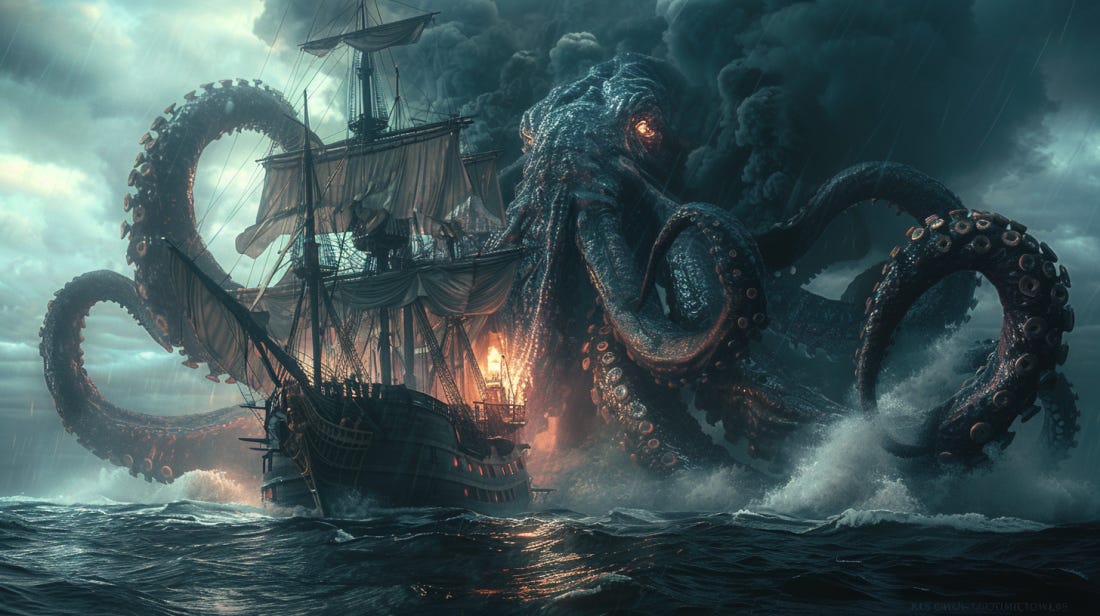
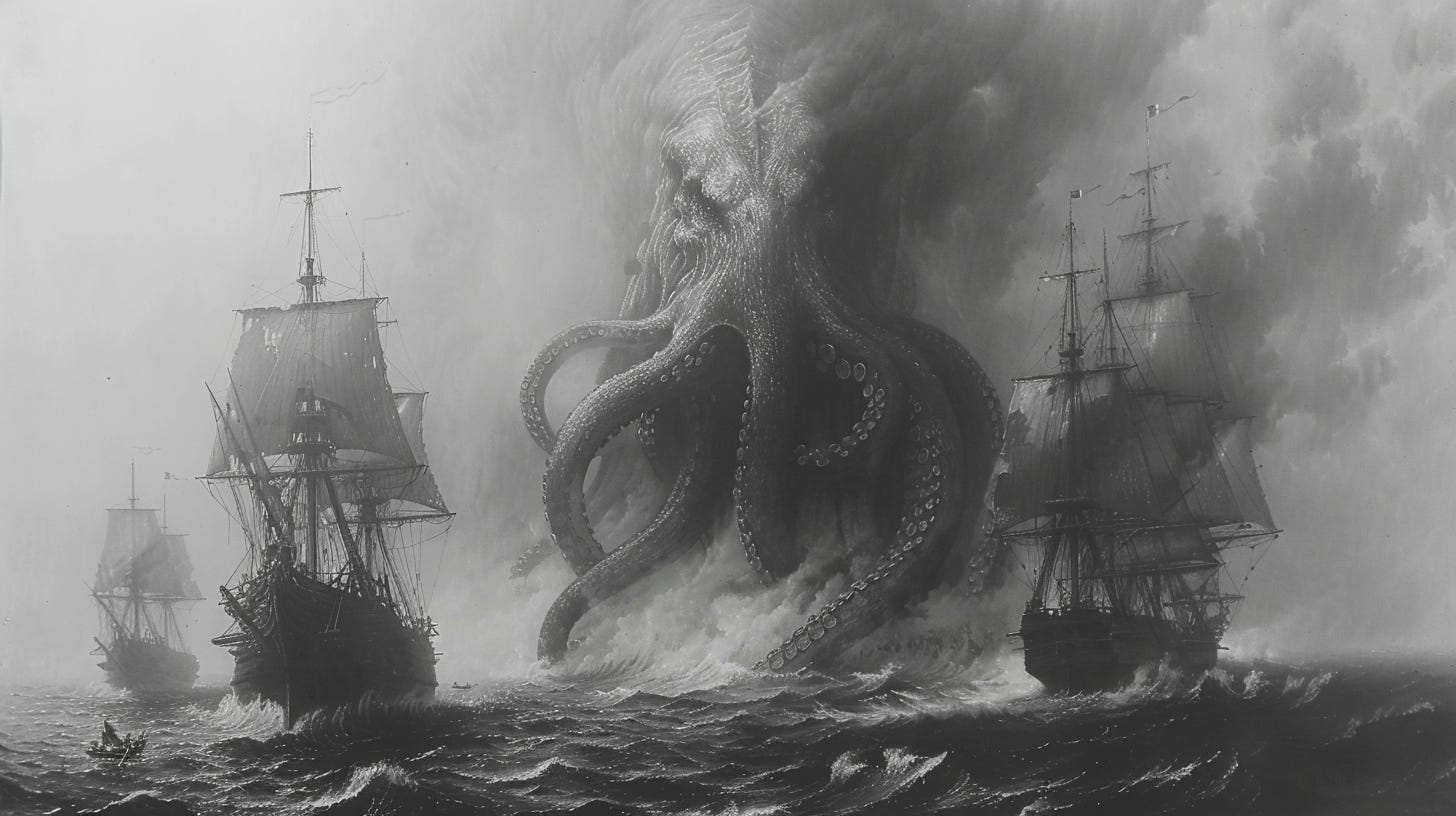
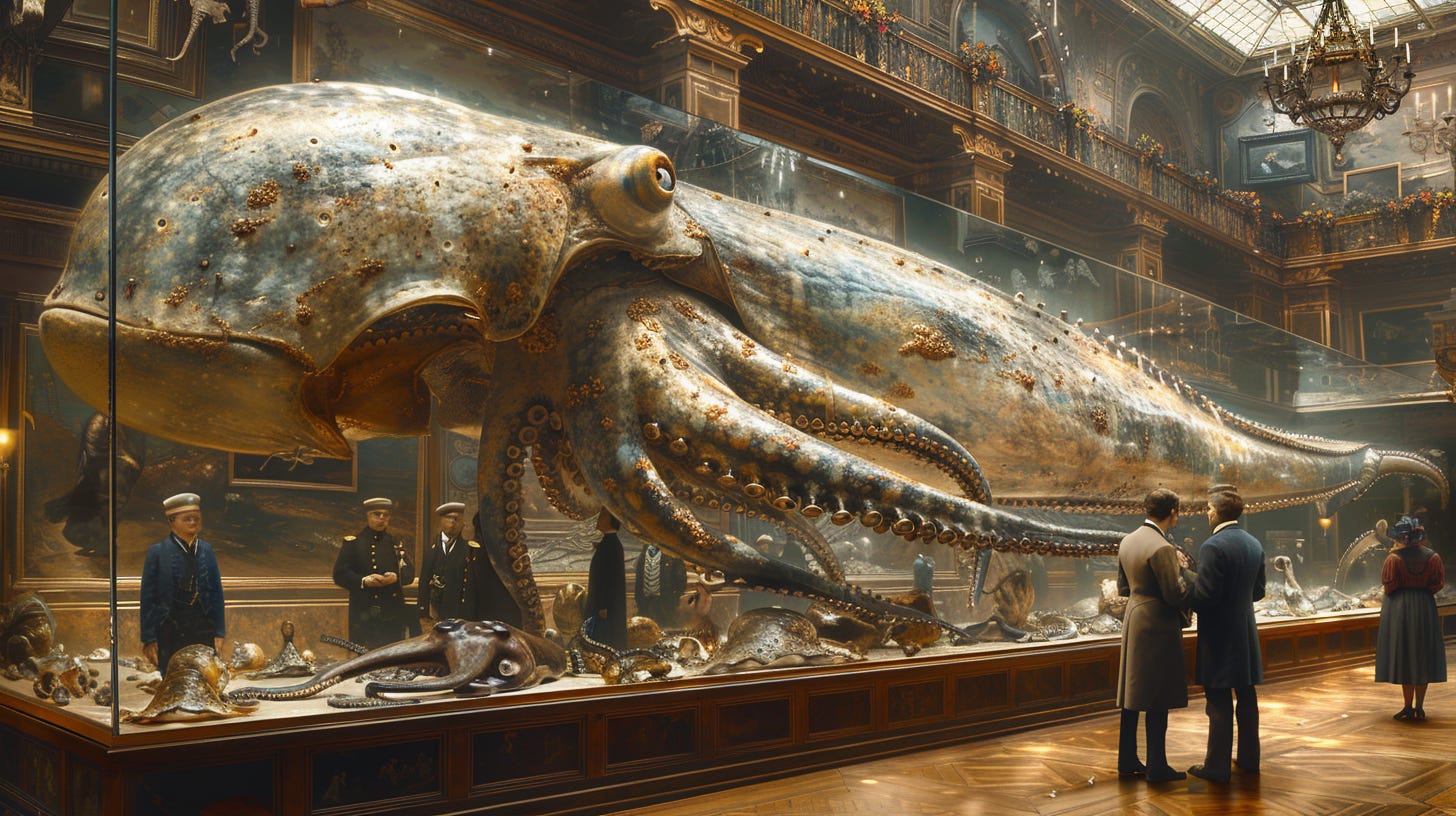
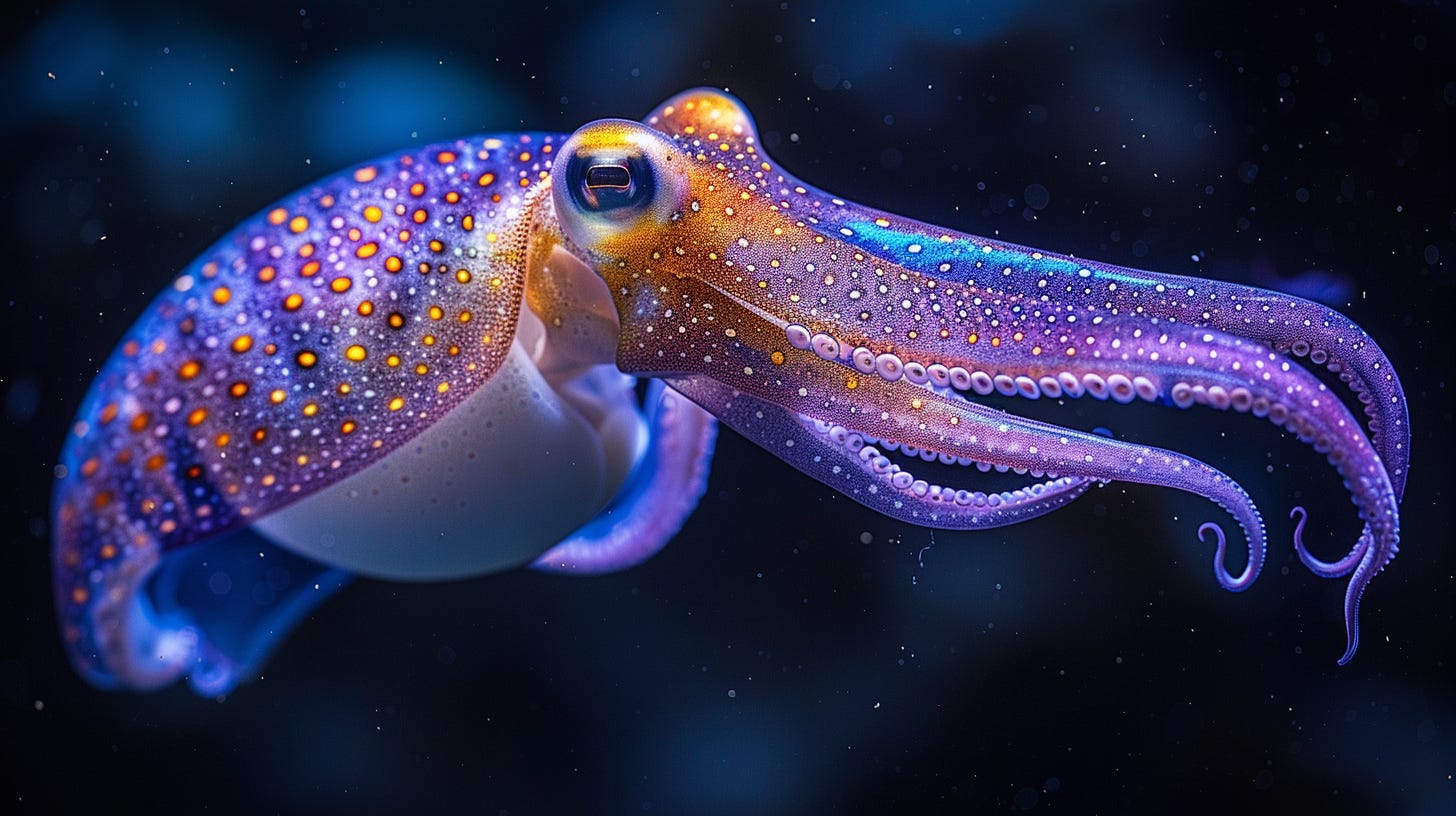
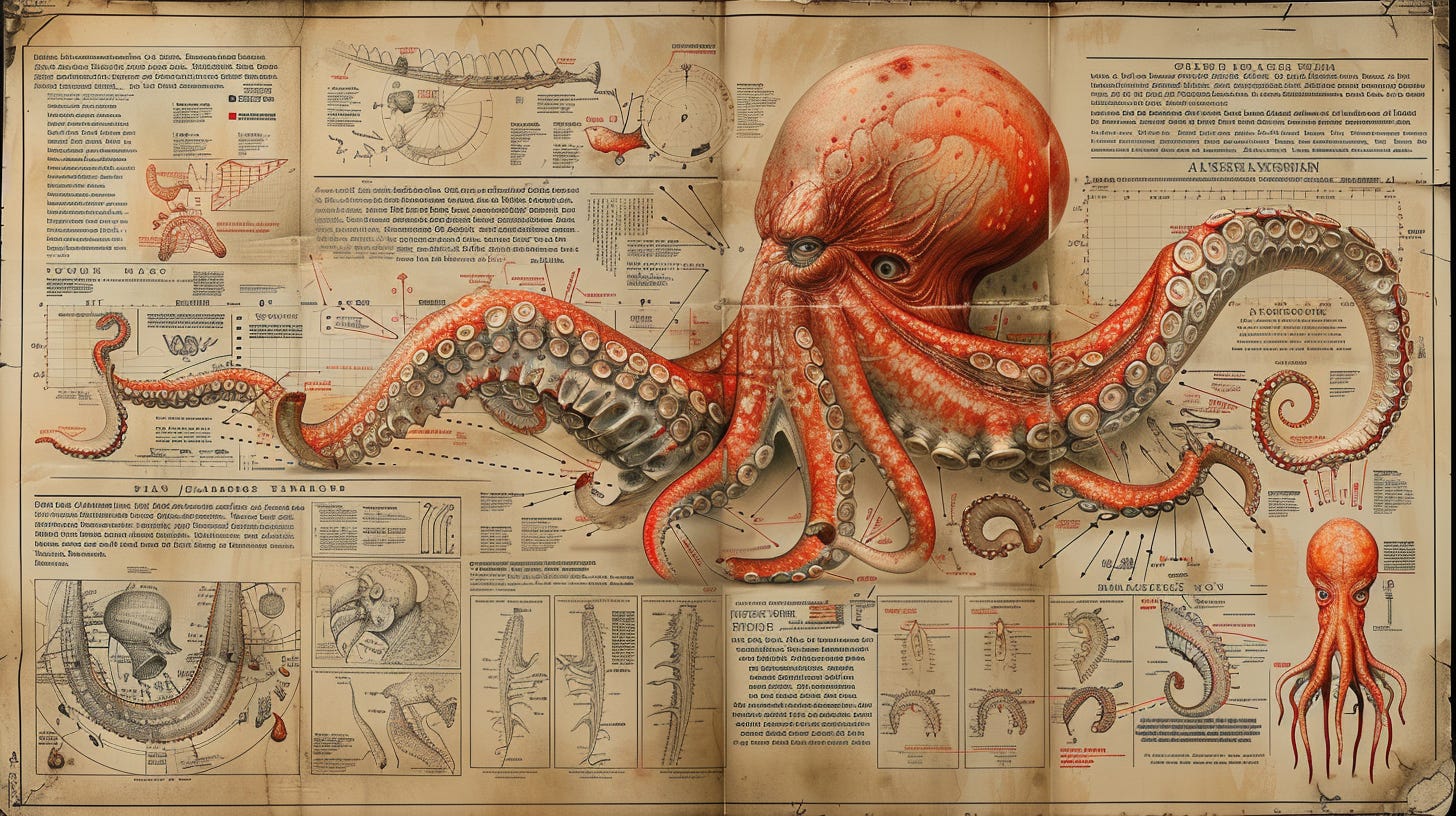
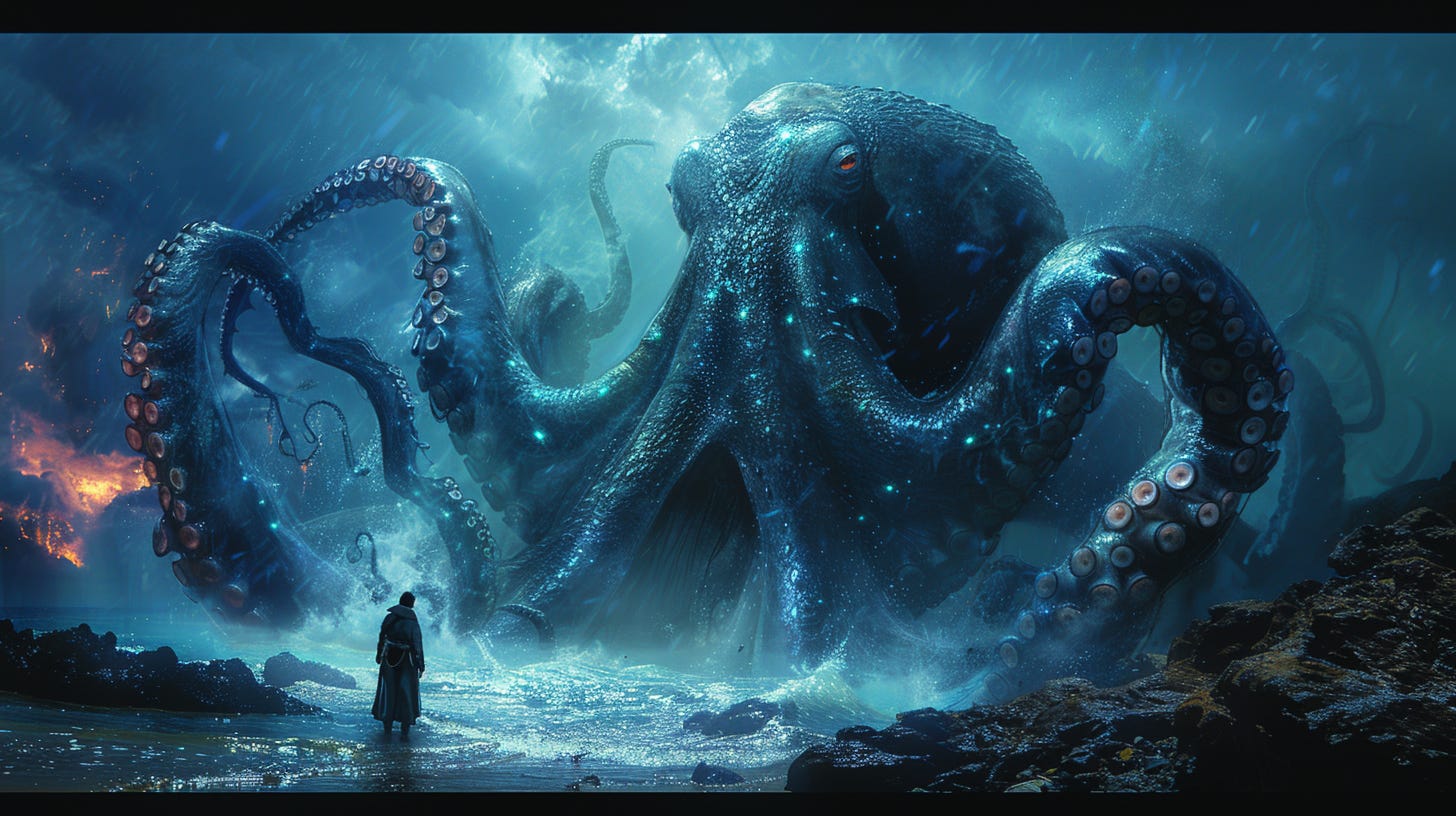
Absolutely fascinating! I'd never considered the rich tapestry of the myths and legends (to say nothing of the science) of the kraken before.